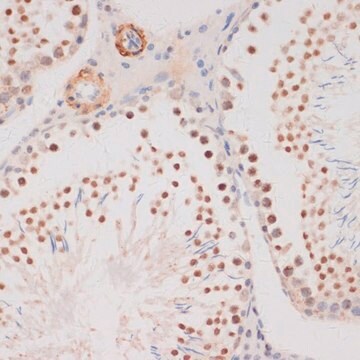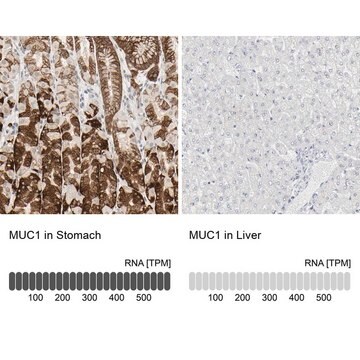Key Documents
SAB4200781
Anti-Haptoglobin antibody, Mouse monoclonal
clone HG-36, purified from hybridoma cell culture
Synonim(y):
Anti-HP, Anti-Zonulin
About This Item
Polecane produkty
pochodzenie biologiczne
mouse
Poziom jakości
forma przeciwciała
purified from hybridoma cell culture
rodzaj przeciwciała
primary antibodies
klon
HG-36, monoclonal
Postać
buffered aqueous solution
reaktywność gatunkowa
human
opakowanie
antibody small pack of 25 μL
stężenie
~1.0 mg/mL
metody
ELISA: 0.2-0.4 μg/mL using 10 μg/ml human haptoglobin for coating
dot blot: suitable
immunoblotting: suitable
immunoprecipitation (IP): suitable
izotyp
IgG1
numer dostępu UniProt
Warunki transportu
dry ice
temp. przechowywania
−20°C
docelowa modyfikacja potranslacyjna
unmodified
informacje o genach
human ... HP(3240)
Opis ogólny
Monoclonal Anti-Haptoglobin specifically recognizes the three types of human haptoglobin (types 1-1, 2-1, and 2-2) The antibody recognizes both purified and haptoglobin in human serum, and shows no crossreactivity with human IgG, transferrin, C-reactive protein, α-1-acid glycoprotein, albumin, hemoglobin, or bovine, goat and sheep serum haptoglobin.
Immunogen
Zastosowanie
Postać fizyczna
Inne uwagi
Nie możesz znaleźć właściwego produktu?
Wypróbuj nasz Narzędzie selektora produktów.
Kod klasy składowania
12 - Non Combustible Liquids
Klasa zagrożenia wodnego (WGK)
WGK 1
Temperatura zapłonu (°F)
Not applicable
Temperatura zapłonu (°C)
Not applicable
Certyfikaty analizy (CoA)
Poszukaj Certyfikaty analizy (CoA), wpisując numer partii/serii produktów. Numery serii i partii można znaleźć na etykiecie produktu po słowach „seria” lub „partia”.
Masz już ten produkt?
Dokumenty związane z niedawno zakupionymi produktami zostały zamieszczone w Bibliotece dokumentów.
Nasz zespół naukowców ma doświadczenie we wszystkich obszarach badań, w tym w naukach przyrodniczych, materiałoznawstwie, syntezie chemicznej, chromatografii, analityce i wielu innych dziedzinach.
Skontaktuj się z zespołem ds. pomocy technicznej








